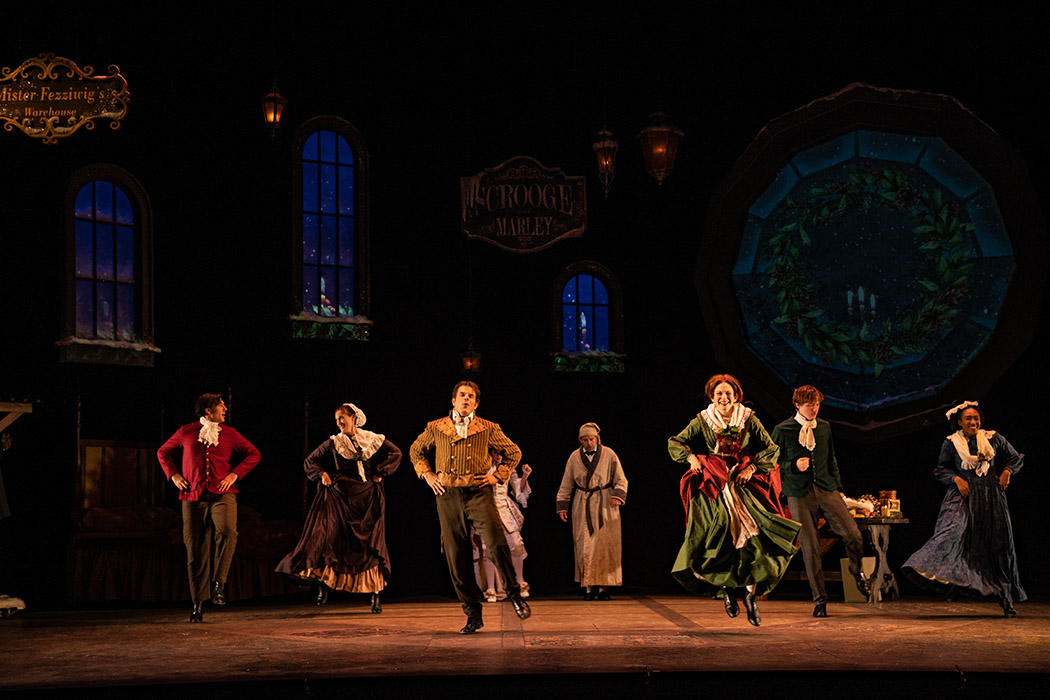Ironically, talking about tradition has itself become a tradition at this time of year. For many, the Christmas season is all about tradition—customs and events repeated just often enough to remain comfortable and familiar. Surely then, by that definition, one of Knoxville’s most compelling Holiday traditions is the Clarence Brown Theatre’s production of Charles Dickens’ A Christmas Carol.
In fact, almost everything about the Dickens work has given in to tradition. For the last 20 years or so of his life, Dickens himself did public readings of A Christmas Carol to counter piracy that deprived him of income. The novella has been a traditional source of adaptations for the stage and screen, the latter alone seeing twenty or so live action films, from 1901 through this year’s Spirited with Will Ferrell as Scrooge. Chalk up a dozen or so animated films of the work. Plus, A Christmas Carol remains one of the most adapted vehicles for the stage, with versions numbering in the hundreds since the 19th Century.
CBT’s own tradition of A Christmas Carol began in 1985, becoming an annual production in 2007. During that time, though, different adaptations have found their way onto the Clarence Brown stage, each with varying adherences to Dickens’ text, theatricality, and use of music. The current production, directed by Amelia Peterson, seems to owe its substance to the 2021 version that was adapted and directed by Professor Emeritus Kate Buckley. That production—and now its descendant—put the emphasis on the actual Dickens text as narration, used a 12-member ensemble in covering the multiple characters, and reduced the size and complexity of the set, as well as the amount and sophistication of traditional music. That 2021 version had the distinct feeling of being condensed and simplified, which in fact it was—it was designed to run without an intermission and work within pandemic recovery precautions.
Peterson’s production has been opened up a bit and relaxed in its energy, giving it an intermission and running at a normal length, but still using the Dickens text as its narration framework. Strangely, while use of familiar period music remains to some degree, it now feels disappointingly unimportant to the seasonal flavor of the drama. And, the interpolation of guitar-accompanied, more contemporary songs seemed a bit out of period and place. Again, this version chooses to minimize and muddy a number of dramatic sub-plots that are generally familiar, particularly the all important Bob Cratchit household and Tiny Tim and the mysterious appearance of Jacob Marley that sets the plot in motion.

The physical production uses a similar spatial arrangement as the previous incarnation, but beautifully tweaked and augmented by scenic designer Katherine Stepanek with lighting by Travis Gaboda. This season’s production also saw an entirely new and different use of projections by DJ Pike to offer period flavor and help energize the special effects. A large clock that loomed over the stage in previous productions, illustrating the importance of time in Scrooge’s night of redemption, is back, but now as a video projection. Tasked with supporting the ensemble as they slip in and out of different characters, costume designer Lauren T. Roark brought muted colors and 19th-Century details that worked beautifully in the grand scheme. Covering a lot of important sonic territory was sound designer Mike Ponder, provider of everything from appropriate bells to music effects that reflected Scrooge’s turmoil, from ticking clocks to effected and eerie amplified voices.
Returning from last season’s production in the character of Ebenezer Scrooge is CBT regular David Brian Alley, again offering a middle-aged Scrooge instead of the oft-pictured elderly curmudgeon. What’s important, though, is that Scrooge’s “bah humbug” be fundamentally believable, a job that Alley accomplishes with relish. Even more important is Scrooge’s transformation from miser to benefactor, a change that Alley pulls off with skill.
The other roles are taken by the ensemble members in a remarkably dizzying tumble of foreground and background action, narration delivery, and…costume changes. Laura Beth Wells, seen recently as an amazing Patsy Cline in Always…Patsy Cline, was a memorable Mrs. Fezziwig and a bold Ghost of Christmas Present. Wells’ presence in the ensemble was simply a joy to watch. Gregory Crane, a welcome newcomer to CBT, was a jolly and giving Fezziwig, and a marvelous chain-encumbered Jacob Marley.
Returning from last season’s ensemble was MFA acting candidate Rachel Darden, putting in a busy evening as Mrs. Cratchit, Miss Ortle, and the Ghost of Christmas Future. Also in from last year, Amberlin McCormack took the role of Scrooge’s young love, Belle, as well as being a dramatically impressive communicator in the narration. Also having a busy night was Joseph Corum, who was very impressive as Scrooge’s nephew Fred, as well as Peter Cratchit, Dick Wilkins, and the Undertaker. Michael Najman, also an MFA candidate, turned in a solidly sympathetic Bob Cratchit and a number of smaller roles. Guthrie Butler was the susceptible-to-greed young Ebenezer and the bachelor Topper. Christine Sage was an eye-opener as the Ghost of Christmas Past, as well as the essential smaller roles of Martha and the housekeeper, Mrs. Dilber. Kage Oakley Harrold and Natalya MacDonald-Risner filled out smaller roles in the ensemble. Golden Littlejohn and Penny Peterson alternated as Tiny Tim and filled a number of the children’s roles.
While audience members that have enjoyed the pre-pandemic productions of CBT’s A Christmas Carol may miss the extensive music score of carols solidly performed and the fun of stagecraft wizardry, the important essence of the original Dickens text can be found here, as well as the important lesson of encouraging those with wealth to help cure the scourge of poverty. We can only hope that those so-blessed get the message.
• • • • • • •








